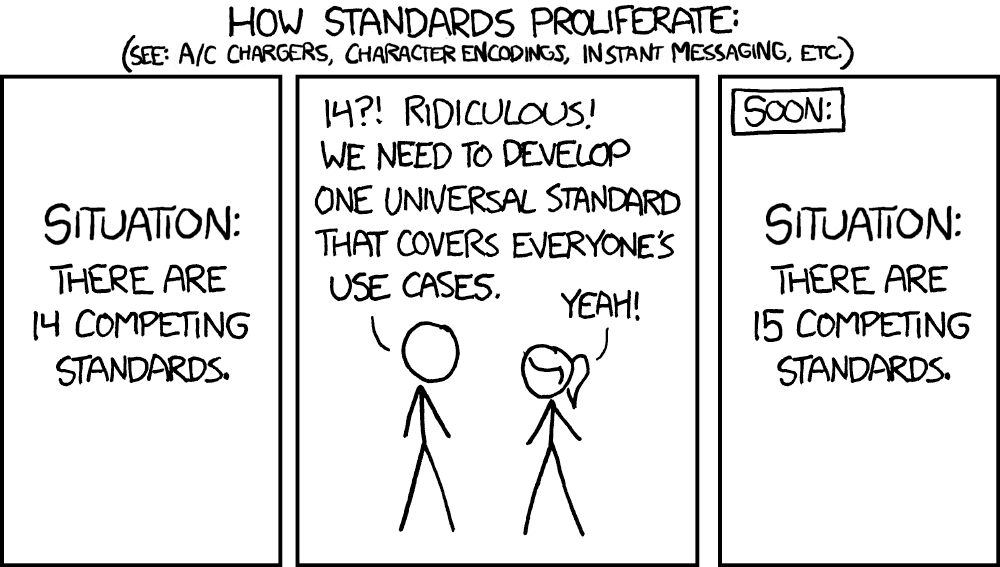Yet another “brilliant” scheme from a cryptobro. Naturally this caused a gold-rush for scammers who outsourced random people via the gig economy to open PRs for this yml file (example)
Actually, I only want to add one file, tea.yml, to your repository. Because I have a job that requires uploading the file and I also don’t know what it is used for.
So you want me to merge a file you use on your job and you don’t know what it does?
I see no issue. Merged!
full send!
LGTM!
It’s hilarious that PR author in that example has monkey profile pic. I guess what people are saying about never trusting people with monkey pfp is true.
For context, Tea (the cli tool) was created by the author of homebrew. But for some reason he changed the name to pkgx and made tea into the crypto thing: From the creator of Homebrew, Tea raises $8.9M to build a protocol that helps open source developers get paid
He’s probably interested in blocking these kinds of PR’s.
He’s probably interested in blocking these kinds of PR’s.
He is now that people are spamming the high profile projects he used as examples in his “get paid” cryptobro scam videos and it’s pissing people off in the FOSS communities hes trying to worm the project into.
Hilariously, he stated that he would be really unhappy if people were doing this to his actual FOSS projects, which makes me wonder why he didn’t use them in his examples instead of the completely unrealted Node.js and ghost projects.
Its almost like he made himself getting rich someone else’s problem. Totally unlike crypt bro behaviour, of course.
That’s insane
Also lol at the people getting mad at the tea maintainer for “name calling” the guy hired to write up the scam PR
Gig economy or not this idiot should have known better
Lol classic reply from the monkey pfp “I didn’t know, I’m sorry, please don’t ban me, sir”. These fuckers know exactly what they’re doing seeing from how they obfuscated the pr purpose, and act all ignorant when caught. It’s exactly the same behaviour game cheaters exhibit when caught red handed
Honestly doesn’t sound like a terrible idea on paper, but this spam outbreak could kill it before it gets off paper in a real way. Giving devs a bad taste will stay around a long while.
Edit: and of course the well-earned general attitude toward cryptocurrency as scammer playgrounds is automatically putting it way in the red too.
Dude also used a LLM to generate descriptions for the packages he’s serving from his package manager. And of course, it got them wrong, creating a headache for the actual package maintainers
I do like the idea of streamlining donations to open source projects directly through a package manager, and crypto seems like a good fit for that (decentralized, uncensorable). The issue here seems similar to knowing what charities are properly using funds; making a system to make decisions about how to spend money is hard when there’s so many people looking to misdirect it to themselves, and the point of this would be to relieve the people who would be donating the money from putting effort into doing the research themselves, so that big problem has to be solved.
which should prevent idiots like @onedionys from being able to figure out how to create the file.
Wow, slow down @mxcl. Calling people names is not constructive not warranted here.
Lmao fuck off
I’ve heard that one so many times it’s not even funny.
Why does the tea project not have users claim ownership of GitHub profiles. That way it could be retroactively applied with no effort on the user or maintainer.
I assume it’s because they don’t just want to count owners but also maintainers. How do you count maintainers? Does one accepted PR count? If not, how many? Counting owners only that would be fine though.
It’s sad that a lot of the username come from Vietnam (my country). I remember when the Stellar airdrop announced there were people trying to buy GitHub account for 3-5$ for “their company’s project”. Many people do the thing that called “MMO” like that here, that doesn’t realistically provide any value. They just want to get rich as fast as possible with only simple jobs such as copy and paste.
I greatly respect the way Vietnam has put things like stable rice prices over Western money. As far as I understand it, this allows for a society where nobody lives in abject poverty. But it also prevents people from getting rich quick by milking their own people. So if I got all of this right, it’s not surprising that some people encountered the idea of getting rich quick through the Internet and try that now.
> nobody lives in abject poverty. But it also prevents people from getting rich quick by milking their own people
lol… no… not at all
Damn, I guess there’s multiple ways to do that.
@flying_sheep probably yes, but if you are looking for a country where people are not living in poverty, where the state takes good care about them or where scammers can’t get rich quick, then Vietnam is unfortunately not it.
Yeah, I think the only thing I really believe about it is that it was a good move to decline the world bank’s conditions for giving Vietnam a loan. Those conditions would have involved allowing international investors to buy land and speculate with food. I think having the ability to fix e.g. rice prices as a government can be very beneficial to a country.
But I don’t want to have an illusory view of how things really are if that’s also wrong.
@flying_sheep I’m with you on that. They protect their own land and economy and it’s only now slowly opening up, they don’t want foreign influence. On the other hand, that means they have total power over their citizens. Having prices dictated by government is cool except if you are the producer. And the prices are still going up anyway, and there is a huge risk regarding rice and climate change, that could have a serious effect in 10-20 years. But come visit, there are many great things too.
Thanks! Yeah, I’ve been there a few years ago and it was lovely. I definitely want to come again some time.
I’ve seen video ads claiming to show you a way towards passive income from other people’s videos somehow. Now it’s coming to open source projects…
Ive seen an uptick in twitch users offering graphics packs for streamers.
I presume some company has figured out the prompts to get AI generated emote packs, and now hire people to offer this service randomly to small/medium streamers.
Am I stupid? How is this in any way confusing?
I kept re-reading this line and it made no sense. All I need to do to claim ownership of a project is merge a pull-request? Do I own Laravel because I’ve gotten a pull request merged? (emphasis mine)
Merging a pull request and having a pull request merged are two completely different things, and one very much requires you to own the project or have contributor rights to it. Which is exactly what the scammer is looking for proof of.
How was the author confused by this? Or am I somehow the dummy here?
@CrayonRosary having a pull request merged is in no way a proof of ownership of the repo, or a sign that the owner wants to participate in this scheme. There are better ways to prove ownership. It’s relatively easy to slip in some file unnoticed, or falsely explain during the PR process what the file represents. So choosing this way of validation is a huge red flag about the whole scheme. It motivates people to falsely claim ownership of popular repos.
having a pull request merged is in no way a proof of ownership of the repo
That’s literally what I was saying! That was the entire point of my comment!
Gitea? What is this?
The easy red flag here is YAML. It’s a hideous, overly-complex format for anything so of course a scam would choose it.
That’s a patently ridiculous statement
Have you read the spec? It’s a total mess
I have read the 1.2 spec (I’m trying to make a round trip parser for JS, and I do maintainance on a fork of the rumel yaml python package). I actually think its very well thought out, with things I hadn’t considered like future extensibility, streaming applications, and data-corruption detection.
The diagrams, color coding, and less-formailty of the spec was much appreciated. Especially compared to something like the ECMA Script spec, which reads like a math textbook had a child with a legal document.
I’m not saying YAML is perfect; round trip (the thing I’m working on) is nearly impossible because it wasn’t a design goal. It has a few too many features (I’ve never seen a declaration in the wild), but it does a good job at accomplishing the creators goals, and the additional features basically only slow down parser-implementers like me. I often pick it because of the tag support, which I’ve struggled to find an equivalent for in other serialization languages. I use anchors in recursive data structures, and complex keys for serializing complex data structures (not human readable). The “document end” marker has been nice when I’m worried about detecting partial-writes. And the merge key is nice for config files.
The application/perspective matters. Yaml might be bad for you but its not bad for everyone.
Even if anchors are pretty novel… I’ve watched myself & others fail for things that seem like they should be simple like scalars, quoting, & indentation rules all for being confusing (while failing to understand how/why the tab character isn’t supported).
That sounds like a skill issue. Something isn’t bad because you don’t understand it. Suggesting quoting is an issue for yaml is beyond the pale; it happens to be an issue everywhere.
Despite my love of yaml. I actually think he has a small point with unquoted strings. I teach students and see their struggles. Bash also does unquoted strings and basically all students go years and years without realizing
cat --help cat "--help" # ^ same thing cat * cat "*" # ^ not same thing cat $thing cat "$thing" # ^ similar but not the sameTo know the difference between special and normal-but-no-quotes you have to know literally every special symbol. And, for example, its rare to realize the
--in --help, isn’t special at a language level, its only special at a convention level.Same thing can happen in yaml files, but actually a little worse I’d say. In bash all the “special” things are at least symbols. But in yaml there are more special cases. Imagine editing this kind of a list:
js_keywords: - if - else - while - break - continue - import - from - default - class - const - var - let - new - async - function - undefined - null - true - false - Nan - InfinityThree of those are not strings. Syntax highlighting can help (which is why I don’t think its a real issue). But still “why are three not strings? Well … just because”. AKA there isn’t a syntax pattern, there’s just a hardcoded list of names that need to be memorized. What is actually challeging is, unless students start with a proper yaml tutorial, or see examples of quotes in the config, its not obvious that quotes will solve the problem (students think
"true"behaves like"\"true\""). So even when they seetrueis highlighted funny, they don’t really know what to do about it. I’ve seem some try stuff like \true.Still doesn’t mean yaml is bad, every language has edge cases.
While the subjective assessment that quote handling in yaml is worse than bash is understandable, it is really just two of many many cases where quotes complicate things. And for a pretty good reason. They are used to isolate strings in many languages, even prose. They, therefore, always get special handling in lexical analysis. Understanding which languages use single quotes, double quotes, backticks, heredocs, etc and when to use them is really just part of the game or the struggle I guess.
Most languages require you to put quotes around strings as the norm… breaking that is part of what causes all of the confusion in the first place. Better design upfront would lead to less common errors. I have way more quoting issues in YAML than I do JSON, Nix, Nickel, Dhall, etc. because they aren’t trying to be cute with strings.
When you’re editing yaml, why not just always write JSON?
Almost all nix attr keys are unquoted strings. Maybe I’m missing the point list, but I kinda wouldn’t expect it to be on the list.
Its easy for me to say “just start writing JSON in the yaml. It doesn’t get more simple than JSON”, but actually I do think there’s a small point with the unquoted strings.
Back before I knew programming, I was trying to change grammar settings sublime 2, which uses yaml. I had no idea what yaml was. The default setting values used unquoted strings fot regex. I knew PCRE regex and escapes, but suddenly they didnt work, and when I tried to match a single quote inside of regex that also didn’t work. I didn’t know I was editing yaml file (it had a
.tmLanguageextension). Even worse, if I remeber correctly, unparsable settings just silently fail. Not only did I have no errors to google, I didn’t have any reason to believe the escapes were the cause of the problem (they worked in the command line). Sometimes I edited the regex and it was fine, and other times it just seemed to break. I didn’t learn about quoting in YAML until years later.For me that was an unfortuate combination, which was exacerbated by yaml unquoted weirdness. But when you’re talking about “did you read the spec” that’s a whole other story.
.nanfor nan, tabs vs spaces, unquted string weirdness, etc should just be one error message+google away. I think they’re a small hiccups with what is overall a great format.
Brief history of YAML:
“Oh no! All of these configuration file formats are complicated. I want to make things simpler!”
(Years go by)
“…I have made things more complicated, haven’t I?”
YAML is generally good if it’s used for what it was originally designed for (relatively short data files, e.g. configuration data). Problem is, people use it for so much more. (My personal favourite pain example: i18n stuff in Ruby on Rails. YAML language files work for small apps, but when the app grows, so does the pain.)
Ansible is using YAML and it’s orders more readable than any other config engine, like puppet or cfengine.
Ideally, yes it can be beautifully written, certainly more than bash scripts.
With that said, I’ve also seen some hideous ansible scripts…

originally designed for (relatively short data files, e.g. configuration data)
This I can get behind. But because it’s not bad in those spaces folks think it’ll be a good idea in all spaces. Anchors do neat things, but organizing large files with YAML’s weird rules around quoting, & no support for tab indentation rub me the wrong way.
What? I love having 20 ambiguous ways to express the same data with weird and unexpected conversion rules. JSON is so much worse - if data types are explicit and obvious, how can I properly express my feelings when writing a config file?
{"foo":true,"bar":{"baz":1}}is valid YAML; better throw it out.I have no issues with using a strict and unambiguous subset of YAML :)
And what would your ideal, legible, general-purpose data markup language be? XML?
Yaml Ain’t Markup Language: am i a joke to you
(JSON for data, TOML for configuration)

I’ve used both YAML and a TOML-adjacent INI format for Ansible. While I wouldn’t use YAML for massive data serialization (because significant whitespaces are fucking stupid), it’s much better suited for manual data entry compared to most options, including TOML, when nested data structures are required.
And if YAML’s structure is too complicated, that’s honestly a skill issue.
Not that YAML’s structure is too complicated, but its syntax is too flexible. All the shit about being whitespace sensitive yet with whitespace errors leading to a syntactically valid YAML document. TOML’s syntax is rigid which makes it unsuitable for expressing complex nested data structures, which is good because that’s not what you should use TOML for. Ultimately the dependence on a highly flexible baseline language like YAML to create complex DSLs is a failure on the developers’ part, and the entire configuration system should be reworked.
Do you use a linter like the ansible vscode extension?
I used to hate writing ansible, and yaml, until I installed the ansible lint vscode extension, and everything became much, much easier.
Later on, when I was working on a docker-compose, I noticed that the vscode yaml extension (which the ansible extension pulled in as a dependency) caught errors. It’s quite intelligent, able to spot errors exactly like what you mentioned, where the yaml syntax is correct, but the docker-compose, or the ansible syntax is wrong.
Of course. If you’re working in a DSL that’s popular enough for someone to have written a good schema/parser for then tooling can help.
Significant white space is awesome! Not supporting tabs tho shows you don’t know what you are doing, YAML.
They very well know what they are doing. Take your filthy tabs and get out of here. Spaces only.
Tabs for indentation, spaces for alignment. It’s perfect. Lets people visually indent as much as they want in their settings, but manually aligned things stay manually aligned. Forcing indents to always be… whatever number of spaces you personally like is dumb.
Plus then you can outdent with a single Backspace in every text editor ever.
😧
Accessibility be damned
set expandtab
Depends on the use case but XML is good for markup—especially if you need extensibility.
For config, Nickel & Dhall take the cake for being typed & having LSPs so the configuration writer can get immediate feedback about possible options (while eliminating invalid states) without requiring the manual—with configuration readers not needing to mess around with marshaling their types. Both these configuration languages let you import files & write little loops to make your config more DRY & makes maintaining large files (like say Kubernetes) easier.
XML is great if the (de-)serialization is already implemented. Otherwise traversing the document is a massive pain.
True. Something like XPath can really help & there are use cases where that is more concise but requires loading XPath into your head like Regex (which tends to get unloaded). The extensibility shines tho as seen by XMPP continuing to this day with very good backwards compatibility with 2 decades of updates since everything in an extension to the base.
RON (Rusty Object Notation). Its like JSON but better.
Do you remember CSON? CoffeeScript Object Notation was a cute way to make JSON readable before CoffeeScript kinda died.
CSON looks like a slightly worse version of YAML to me
Parsing rules are way simpler… it was also a different time.
as a rustacian i cannot thank you enough for notifying me of this
I see you get downvoted a lot. But as a norwegian that repeatedly have run into the norwegian problem when trying to use some program… i see you.
What’s the weather like in
False?It’s practically nonexistent
Soggy snow!
YAML 1.2 was released 15 years ago and fixed this issue. The problem is not YAML but the libraries people are using to parse it being a decade and a half out of date.
Does this mean docker compose files are bad?
💯 Switch to Nix immediately
If you think “crypto” people came up with this I have bad news for you, spamming is as old as the internet, and adding ads to repos is not new. Btw, “cryptobro” is a sexist term that excludes women.
Are you excluding women from being a bro? That’s kinda sexist of you.
…are you gatekeeping scam lore?
Btw, “cryptobro” is a sexist term that excludes women.
We can start calling them “cryptoclowns”.
Cryptosiblings
Are you sure this is christian, step-cryptosibling?
The person responsible for this is a man…
Btw, “cryptobro” is a sexist term that excludes women.
I’m usually that person getting downvoted for insisting on inclusive language so I totally get you, but girl I’ve never met a cryptobro who wasn’t a man.
Caroline Ellison
Ruja Ignatova
Damn, OneCoin was bad. Ruja Ignatova was the first crypto scammer I’ve seen talked about in national news and she was also made fun of in a news comedy show over here. A true scam pioneer.
Technically not a cryptosis as onecoin wasn’t a cryptocurrency, that was part of the scam.
There’s two kinds of crypto scams: Ones that actually involve crypto and ones that don’t.
Vague, possibly impossible to implement promises about proposed future functionality is an integral part of the crypto sphere!
Fair perspective. It is a scam happing in the crypto sphere but that doesn’t necessarily make her a cryptosis. I mean, it comes down to what makes a cryptosis a cryptosis, acting in the crypto sphere or believing in crypto or holding crypto?
Are you one of the people who thinks what you don’t know doesn’t exist? How did you manage to find lemmy if you can’t use a search engine?
You saying cryptobro is sexist just reinforces your own stupidity.
Hilarious well done
Admins please include instance blocking for comments, thanks. No instance ending in .de ever has anything of value to say.
Sounds like a sensible proposal, by domain or by tld.



















